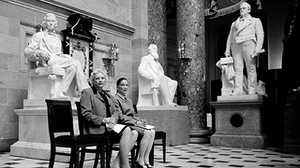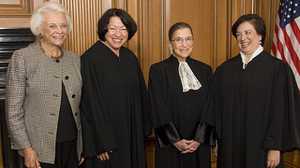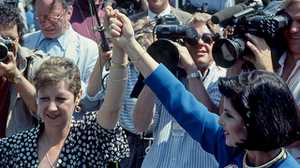Sandra Day O’Connor’s Journey to Supreme Court Justice
How the Arizona lawyer became one of the most powerful women in America.

In the late 1970s, Sandra Day O’Connor, then a judge for the Maricopa County Superior Court in Arizona, wrote a note to herself. “Don’t let fate take over,” it said in her neat cursive script. “You can influence your destiny.” In August 1979, she would have that opportunity. Warren Burger, then Chief Justice of the United States Supreme Court, traveled to her home state for a judicial conference in Flagstaff. Burger’s chief of staff had asked local contacts to suggest a pastime for his boss following the conference. The result was a houseboat excursion on Lake Powell with a group of legally savvy friends. O’Connor and her husband, both lawyers by training and fixtures on the Arizona social scene, were invited. And so she found herself, in late summer, floating on a manmade reservoir with the country’s preeminent judge for three days.
We just had a fabulous time,” O’Connor recalled later. “Sometimes we would sit in inner tubes and float in the lake, and sometimes we’d fish, and sometimes we’d just sit on the houseboat as we went along. It was a great trip.” Most significantly for O’Connor’s career, she and Burger talked. Each night, O’Connor and “the Chief,” as he liked to be called, stayed up well past midnight comparing notes on politics and the law.
Afterward, Burger became one of her boosters. In order to raise her profile in the legal community, he had her added to the Anglo-American Legal Exchange, a prestigious annual get-together for American and British jurists. When O’Connor attended the gathering the following summer, the reunion was fond. “I was glad to see him,” she recorded in a diary. “He is warm and friendly.” By then, her own professional standing had risen another level. In December 1979, Arizona’s governor selected O’Connor to be a judge on the state’s Court of Appeals. As Arizona’s second-highest court (above it remained only the state’s federal Court of Appeals), the new position gave O’Connor more national visibility, particularly within the very small cadre of female Republican judges. It was the promotion to this role that brought her to the attention of an even more prominent person.
During his 1980 presidential campaign, Ronald Reagan grew concerned that he lagged his opponent Jimmy Carter in polls with female voters. Two weeks before Election Day, Reagan announced that he would nominate a woman to one of the first Supreme Court vacancies of his hopeful administration. The president had only been in office a few months when then-Supreme Court Justice Potter Stewart gave notice, privately, that he planned to step down. The U.S. Attorney General’s office in turn began a furtive search for Stewart’s replacement.
Attorney General William French Smith kept a short list of contenders on the back of a message slip on his desk in the Justice Department. O’Connor’s name was on this exclusive roster of potential woman justices. She was the least well-known of the group. But in addition to Burger’s stamp of approval, she had another judge on the High Court in her corner. Justice William Rehnquist and O’Connor had been contemporaries at Stanford Law School in the early 1950s, even dating for a period. He lobbied for her appointment from behind the scenes.
The formal invitation came on June 25, 1981. When Attorney General Smith asked whether O’Connor would travel to Washington, D.C. for an interview, she replied, mischievously: “I assume you’re calling about secretarial work?” A younger O’Connor had queried dozens of California law firms for a position upon her graduation from Stanford but came up hard against the legal profession’s sexism. Her only interview came from a firm where Smith was previously a partner, Gibson, Dunn & Crutcher. Her interviewer there asked her how well she could type.

O’Connor met President Reagan in the Oval Office several days later. Her knack for befriending powerful men once again served her well. “She puts you at ease," a participant in the meeting remarked to TIME magazine. "She's a real charmer."
The nomination was hers. The President officially announced her appointment to the Supreme Court on July 7. “She is truly a person for all seasons,” he told an audience of reporters in the White House briefing room, “possessing those unique qualities of temperament, fairness, intellectual capacity and devotion to the public good which have characterized the 101 brethren who have preceded her."
One hurdle remained before she could become Justice number 102: the confirmation hearings. O’Connor put herself through rigorous training preparations. Over five days, she met with 39 senators in advance of the hearings, paying special visits to potential political opponents. Then, over the next two months, she crammed with the intensity of a first-year law school student. None of her judicial appointments to date had required knowledge of constitutional law, and O’Connor had an abundance of remedial learning to do. Her preparations even included a visit, before the confirmation hearings began, to the chamber where they would be held. As a result she knew what to expect two days later: Dozens of cameras were already trained where she would be seated, the focus of the room.

Her hearings before the Senate Judiciary Committee were the first of any Supreme Court nominee’s to be broadcast live on television, and tens of millions tuned in. O’Connor’s interrogators attempted, time and again over three days, to probe her on the most controversial issue surrounding her nomination: What was her stance on the 1973 Roe v. Wade decision legalizing abortion? She answered adroitly, alternating among circumspection, evasion and in-depth legalistic analysis. “Through three days of hearings,” TIME commented after their conclusion, “O'Connor retained total control of the proceedings.” Her Senate confirmation was unanimous at 99 votes to 0.
On September 25, 1981, O’Connor raised her right hand and repeated the oath for incoming members of the Supreme Court, read aloud to her by “the Chief,” now her senior-most colleague. In becoming the court’s first female judge, O’Connor had been master of her own destiny. Now, and over the next 24 years, she would influence the destiny of an entire nation.

Women lead advancements in science, technology, politics, sports and activism—often fighting against inequity and opposition at every turn.
In this collection, explore films, interviews, articles, image galleries and more for an in-depth look at notable female figures in American history.







